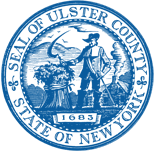On August 19, 2025, New York State recertified Ulster County Agricultural District #3 per Article 25AA § 303-a (agricultural districts review) of New York State Agriculture and Markets Law.
Maps of Agricultural District #3:
- Rochester (central, southeast), Marbletown, Olive, and Rosendale
- Wawarsing and Rochester (southwest)
- Denning and Rochester (northwest)
- Hardenburgh
- Municipal Boundaries - Rondout Valley
- Topography - Entire District
The maps above show the District after its periodic review was completed in July 2025. The number of tax parcels in an Ulster County agricultural district is very likely to change after its review. Maps #1, #2, #3, and #4 were created by Ulster County Information Services and submitted to Cornell University's Institute for Resource Information Sciences and the New York State Department of Agriculture and Markets.
Description of Agricultural District #3
Agricultural District #3 is centered in the Rondout Valley. Most of the farming in the District takes place in the low-lying area around the Rondout Creek, which has some of the best soils in New York State. This core area stretches from the southern half of Marbletown, through Rochester, and into Wawarsing, ending just before Ellenville. The District has also added more locations outside the low-lying area around the Rondout Creek. Although these areas are located outside the traditional core area of agriculture in the District, they illustrate the overall health of Agricultural District #3.
One example of this activity includes agriculture in Hardenburgh. Part of a farm entered Agricultural District #3 in 2004 with another section added as recently as 2012. These parcels were included in Agricultural District #3 for administrative reasons, as they are located well outside the Rondout Valley. Hardenburgh has a sizable farming community, which includes cattle and maple sugaring operations.
Closer to the Rondout Valley, in the higher elevations around it, Agricultural District #3 has a concentration of parcels in Wawarsing. These parcels are found along Wawarsing’s mountainous border with the Towns of Neversink and Fallsburg in Sullivan County. These agricultural lands are close to farms in Sullivan County. Together, they form a small agricultural region of their own. (Most of the land within an agricultural district in Sullivan County lies farther to the west, between State Route 17 and the border with Pennsylvania.)
Agricultural District #3 added many parcels as annual additions in these upland areas away from the Rondout Creek. These upland areas include all towns in the District. Of the 75 tax parcels included in the District since 2006, only seven are in the low-lying area around the Rondout Creek. Some of these 75 parcels belonged to existing farms with land already in the agricultural district. Most, however, had agricultural operations with no existing relationship to the New York State Certified Agricultural District Program.
The farms that sought inclusion into the agricultural district program for the first time represent a variety of agriculture. Some horse boarding operations entered the agricultural district after a change to New York State law in 2011 that recognized them as farms. Along both sides of the border with the Towns of Rochester and Olive, parcels encompassing a 635-acre area were included between 2004 and 2016, with operations focusing on haying and livestock. Farms focused on cut flowers have been included in the Rondout Valley since 2022. Wawarsing continues to see parcels added into the agricultural district after years of routinely seeing none with new farms focusing on niche markets like goat milk products and mushrooms requesting inclusion. These upland areas attracted new farms.
The Rondout Valley has long had important connections to the wider region. In the 19th Century, the Delaware & Hudson (D&H) Canal ran alongside the Rondout Creek, connecting Pennsylvania to the Hudson River by way of Sullivan and Ulster Counties. The demand for Pennsylvania coal in the major cities of New York State and beyond was the impetus for the D&H Canal’s construction. However, other industries in the Rondout Valley benefitted, since the D&H Canal facilitated movement of bluestone, lumber and agricultural products to various markets beyond the Valley. Towns and hamlets formed along the D&H Canal during its heyday because of economic opportunities. In time the movement of goods was supplanted by the Kingston Branch of the New York, Ontario & Western (O&W) Railroad. By the time this branch of the O&W Railroad went defunct in the late 1950s, State Route 209, which runs alongside the Rondout Creek in the Rondout Valley, connected with the newly built New York State Thruway.
Currently, a variety of farms and organizations connected to farming are located around State Route 209. In Wawarsing, outside of Ellenville and not far from Route 209, a food distributor is a licensed farm products dealer through the New York State Department of Agriculture and Markets. Going north on Route 209, into Rochester, a seed company continues to sell heirloom and open-pollinated seeds but in a brand-new facility. Also in Rochester, a few of the oldest farms in America live on through different income streams involving agritourism, direct sales, and of course, crop production.
Agricultural District #3 is bordered on the north by Agricultural District #4 and the Lower Esopus Valley. The agricultural services industry has grown in Agricultural District #4, particularly along Route 209. Together, these agricultural districts provide protection for lands along the Rondout and Esopus Creeks, with this reach extending into adjoining upland areas.
Location has long made Agricultural District #3 and the Rondout Valley viable for agriculture. To the longtime benefit of the District’s farms, it not only has great soils and various resources, but region-wide access to consumers, too. (updated 3/17/2025)
Contact Burt Samuelson of the Ulster County Planning Department with questions at (845) 339-2490 or bsam[at]co.ulster.ny[dot]us

